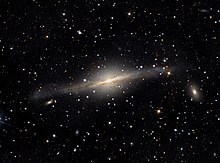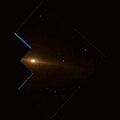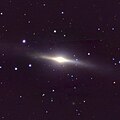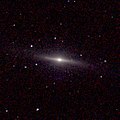NGC 5084
| NGC 5084 | |
|---|---|
 NGC 5084 by 32 in Schulman Telescope | |
| Observation data (J2000 epoch) | |
| Constellation | Virgo |
| Right ascension | 13h 20m 16.9s[1] |
| Declination | −21° 49′ 39″[1] |
| Redshift | 0.005741 ± 0.000010 [1] |
| Helio radial velocity | 1,721 ± 3 km/s[1] |
| Distance | 80.5 Mly (24.7 Mpc)[2] |
| Apparent magnitude (V) | 10.5[3] |
| Characteristics | |
| Type | S0 [1] |
| Apparent size (V) | 9′.3 × 1′.7[1] |
| Notable features | Supermassive disk galaxy |
| Other designations | |
| ESO 576- G 033, MCG -04-32-004, PGC 46525[1] | |
NGC 5084 is a lenticular galaxy in the constellation of Virgo. It is located at a distance of circa 80 million light years from Earth, which, given its apparent dimensions, means that NGC 5084 is at least 200,000 light years across. It is one of the largest and most massive galaxies in the Virgo Supercluster. It was discovered by William Herschel on March 10, 1785. The galaxy is seen nearly edge-on, with inclination 86°, and features a warped disk and large quantities of HI gas extending along the disk, probably accumulated after multiple accretions of smaller galaxies.[4]
Mass and size estimates[]
NGC 5084 is a very massive system, with a high rotational speed of about 328 km/s.[4] It is categorised as a supermassive disk galaxy.[5] Gottesen (1986) estimated based on the rotational speed that the mass of NGC 5084 is 8.5 x1011 M☉ and its radius to be 34 kpc (110 kly) for an estimated distance of 15.5 Mpc (50 Mly).[4] Gottesman et al. (2002) using the same method adopted as distance the 30 Mpc and calculated the mass of NGC 5084 to be 1.7 x 1012 M☉.[6] Koribalski et al. (2004) measured the rotational speed of NGC 5084 to be 334 km/s and calculated its mass to be 1.3 × 1012 and its radius was estimated at 50 kpc (163 Kly).[7] Carrignan et al. (1997) measured the velocity differences and projected separations of nine galaxies they identified as satellites of NGC 5084 and using different equations they estimated the mass of NGC 5084 to be between 6 x 1012 M☉ and 1 x 1013 M☉, which was at that time the highest mass ever derived for a disk galaxy. They estimated the optical diameter of NGC 5084 to be 74 kpc (241 Kly).[8]
Nearby galaxies[]
NGC 5084 is the largest galaxy in the NGC 5084 group, which also includes NGC 5087 and and some smaller galaxies. The galaxy group is compact, showing little redshift dispersion. NGC 5068 is a foreground galaxy.[9] Other nearby galaxy groups include the NGC 5078 group, which includes NGC 5078, , and NGC 5101, and group.[10] NGC 5084 is located at end of Virgo II groups, a filament of galaxy groups that extents southwards from the Virgo cluster.[11]
See also[]
- NGC 1961 - a supermassive spiral galaxy
- UGC 12591 - a supermassive lenticular/spiral galaxy
Gallery[]

NGC 5084 (SDSS DR14)

NGC 5084 by Hubble Space Telescope

Pan-STARRS image of NGC 5084

NGC 5084 by 2MASS
References[]
- ^ a b c d e f g "NASA/IPAC Extragalactic Database". Results for NGC 5084. Retrieved 2016-01-18.
- ^ Theureau, G.; Hanski, M. O.; Coudreau, N.; Hallet, N.; Martin, J.-M. (19 December 2006). "Kinematics of the Local Universe". Astronomy & Astrophysics. 465 (1): 71–85. arXiv:astro-ph/0611626. Bibcode:2007A&A...465...71T. doi:10.1051/0004-6361:20066187. S2CID 14251529.
- ^ "NGC5084". HyperLeda. University of Lyon.
- ^ a b c Gottesman, S. T.; Hawarden, T. G. (1 April 1986). "Optical and high-resolution H I observations of the massive and unusual lenticular galaxy NGC 5084". Monthly Notices of the Royal Astronomical Society. 219 (4): 759–775. Bibcode:1986MNRAS.219..759G. doi:10.1093/mnras/219.4.759.
- ^ Buson, L. M.; Galletta, G.; Saglia, R. P.; Zeilinger, W. W. (March 1991). "Supermassive disk galaxies". ESO Messenger. 63 (63): 50–52. Bibcode:1991Msngr..63...50B. ISSN 0722-6691.
- ^ Gottesman, S. T.; Hunter, J. H.; Boonyasait, V. (November 2002). "On the mass of M31". Monthly Notices of the Royal Astronomical Society. 337 (1): 34–40. arXiv:astro-ph/0207450. Bibcode:2002MNRAS.337...34G. doi:10.1046/j.1365-8711.2002.05793.x. S2CID 119429719.
- ^ Koribalski, B. S.; Staveley-Smith, L.; Kilborn, V. A.; Ryder, S. D.; Kraan-Korteweg, R. C.; Ryan-Weber, E. V.; Ekers, R. D.; Jerjen, H.; Henning, P. A.; Putman, M. E.; Zwaan, M. A.; de Blok, W. J. G.; Calabretta, M. R.; Disney, M. J.; Minchin, R. F.; Bhathal, R.; Boyce, P. J.; Drinkwater, M. J.; Freeman, K. C.; Gibson, B. K.; Green, A. J.; Haynes, R. F.; Juraszek, S.; Kesteven, M. J.; Knezek, P. M.; Mader, S.; Marquarding, M.; Meyer, M.; Mould, J. R.; Oosterloo, T.; O'Brien, J.; Price, R. M.; Sadler, E. M.; Schröder, A.; Stewart, I. M.; Stootman, F.; Waugh, M.; Warren, B. E.; Webster, R. L.; Wright, A. E. (July 2004). "The 1000 Brightest HIPASS Galaxies: H Properties". The Astronomical Journal. 128 (1): 16–46. arXiv:astro-ph/0404436. Bibcode:2004AJ....128...16K. doi:10.1086/421744. S2CID 16229767.
- ^ Carignan, Claude; Cote, Stephanie; Freeman, Kenneth C.; Quinn, Peter J. (May 1997). "NGC 5084: A Massive Disk Galaxy Accreting its Satellites?". The Astronomical Journal. 113: 1585. arXiv:astro-ph/9704032. Bibcode:1997AJ....113.1585C. doi:10.1086/118376.
- ^ Firth, P.; Evstigneeva, E. A.; Jones, J. B.; Drinkwater, M. J.; Phillipps, S.; Gregg, M. D. (11 November 2006). "Kinematics, substructure and luminosity-weighted dynamics of six nearby galaxy groups". Monthly Notices of the Royal Astronomical Society. 372 (4): 1856–1868. arXiv:astro-ph/0608584. Bibcode:2006MNRAS.372.1856F. doi:10.1111/j.1365-2966.2006.10993.x. S2CID 18646500.
- ^ Makarov, Dmitry; Karachentsev, Igor (21 April 2011). "Galaxy groups and clouds in the local (z∼ 0.01) Universe". Monthly Notices of the Royal Astronomical Society. 412 (4): 2498–2520. arXiv:1011.6277. Bibcode:2011MNRAS.412.2498M. doi:10.1111/j.1365-2966.2010.18071.x. S2CID 119194025.
- ^ "The Virgo II Groups". www.atlasoftheuniverse.com.
External links[]
| Wikimedia Commons has media related to NGC 5084. |
- NGC 5084 on WikiSky: DSS2, SDSS, GALEX, IRAS, Hydrogen α, X-Ray, Astrophoto, Sky Map, Articles and images
- Lenticular galaxies
- Virgo Supercluster
- Virgo (constellation)
- Discoveries by William Herschel
- NGC objects
- Principal Galaxies Catalogue objects



